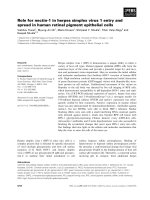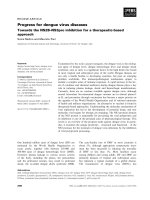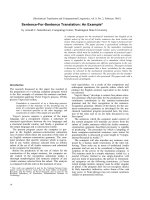báo cáo khoa học: " Circumcision for prevention against HIV: marked seasonal variation in demand and potential public sector readiness in Soweto, South Africa" pdf
Bạn đang xem bản rút gọn của tài liệu. Xem và tải ngay bản đầy đủ của tài liệu tại đây (205.78 KB, 3 trang )
BioMed Central
Page 1 of 3
(page number not for citation purposes)
Implementation Science
Open Access
Short report
Circumcision for prevention against HIV: marked seasonal variation
in demand and potential public sector readiness in Soweto, South
Africa
Guy de Bruyn*
1
, Martin D Smith
2
, Glenda E Gray
1
, James A McIntyre
1
,
Russell Wesson
2
, Gary Dos Passos
2
and Neil A Martinson
1,3
Address:
1
Perinatal HIV Research Unit, University of the Witwatersrand, Johannesburg, South Africa,
2
Department of Surgery, Chris Hani
Baragwanath Hospital, and University of the Witwatersrand, Johannesburg, South Africa and
3
School of Medicine, Johns Hopkins University,
Baltimore, MD, USA
Email: Guy de Bruyn* - ; Martin D Smith - ; Glenda E Gray - ;
James A McIntyre - ; Russell Wesson - ; Gary Dos Passos - ;
Neil A Martinson -
* Corresponding author
Abstract
The public sector delivery of male circumcision in the only public sector hospital in Soweto, South Africa
was examined to gauge local capacity to deliver this procedure as an intervention for prevention of HIV
acquisition. During the period from July 1998 to March 2006, approximately 360 procedures were
performed per annum. Striking seasonal variations and the relatively few procedures performed may create
challenges for program planning, if male circumcision is increased to a level required to have an impact on
the incidence of HIV among this population.
Findings
A recently completed randomized controlled trial of male
circumcision (MC) for the prevention of HIV acquisition
demonstrated that MC reduces the risk of HIV infection
[1], confirming similar findings from many prior observa-
tional studies [2]. At the efficacy and cost of the procedure
reported in the trial, MC may be cost-saving as a public
health intervention [3]. These findings add to the options
for personal prevention of HIV acquisition, and support
the addition of MC as a component of prevention pro-
grams in countries with a high prevalence of HIV. In the
absence of UNAIDS endorsement to back policy and pro-
gram development [4], implementation issues need to be
debated.
However, to have an impact, a large proportion of the
male population would have to be circumcised. Indeed,
this conclusion is supported by epidemic modeling for
the population of Soweto [5], and at a country level in
South Africa [6]. The current live male birth cohort in
Soweto numbers approximately 15,000 per year (J. McIn-
tyre, personal communication). The prevalence of MC is
estimated to be between 20% and 35%, based on surveys
in communities within 100 km of Soweto [7,8]. Popula-
tion coverage of 60% of males within a birth cohort, with-
out expanding to other uncircumcised men, would
require at least 8,000 procedures per year. Additionally,
MC appears to be acceptable to the majority of uncircum-
cised men in this area, if found to be beneficial in the pre-
vention of HIV/STI's [7,8]. Partner preferences are
commonly cited as a reason for adult men undergoing the
procedure, because women find it acceptable as well.
Published: 25 January 2007
Implementation Science 2007, 2:2 doi:10.1186/1748-5908-2-2
Received: 24 August 2006
Accepted: 25 January 2007
This article is available from: />© 2007 de Bruyn et al; licensee BioMed Central Ltd.
This is an Open Access article distributed under the terms of the Creative Commons Attribution License ( />),
which permits unrestricted use, distribution, and reproduction in any medium, provided the original work is properly cited.
Implementation Science 2007, 2:2 />Page 2 of 3
(page number not for citation purposes)
Furthermore, South African investigators will soon initiate
clinical research studies in HIV prevention, such as large
HIV vaccine efficacy studies involving several thousand
male participants. One of these trial sites is in Soweto. The
ethical justification for the adoption of such measures as
part of the standard of prevention for trial participants is
still being debated, but clinical trial investigators would
likely facilitate referral to medical services rather than tra-
ditional services, potentially adding a further burden to
existing circumcision facilities [9,10].
However, it is currently unclear what capacity exists to
supply circumcision on a scale to have an impact on HIV
transmission in Soweto, a large urban township in the
Johannesburg metropolitan area of South Africa with a
population of approximately 1.1 million. To assess their
existing medical capacity to undertake a large-scale cir-
cumcision program, we audited the procedure logs of the
operating rooms of a 3,000-bed, public-sector hospital in
Soweto, the only one serving this community, to docu-
ment how many circumcision procedures were provided
in recent years.
The numbers of circumcision procedures were retrieved
from operating room logs for those procedures performed
at Chris Hani Baragwanath Hospital by adult general sur-
gical services between July 1998 and March 2006, and by
the pediatric surgery service between July 2003 and March
2006. The indication for circumcision was not available
from the logs.
The survey found that 2,786 procedures were performed
in the 93 continuous months of adult general surgical pro-
cedure logs available for review (mean ± standard devia-
tion, 30 ± 13.1/month). The mean age of patients was
22.6 years (SD 8.8). The number of procedures varied
strongly by season (Edwards test, p < 0.0001), being great-
est in the winter months, with marked peaks in July or
August and low rates in the summer months of December
and January. The median age of males undergoing proce-
dures also varied by season, with the median age being
lower during peak months compared to months with
lower rates (Figure 1). The median age showed a signifi-
cant decline over the period (Cuzick test, p < 0.001).
Circumcision procedures performed by general surgical services, Chris Hani Baragwanath Hospital, Soweto, Jul 1998 – Mar 2006Figure 1
Circumcision procedures performed by general surgical services, Chris Hani Baragwanath Hospital, Soweto,
Jul 1998 – Mar 2006. Bars represent number of procedures performed per month. Line represents median age (in years) of
patients by month.
Publish with BioMed Central and every
scientist can read your work free of charge
"BioMed Central will be the most significant development for
disseminating the results of biomedical research in our lifetime."
Sir Paul Nurse, Cancer Research UK
Your research papers will be:
available free of charge to the entire biomedical community
peer reviewed and published immediately upon acceptance
cited in PubMed and archived on PubMed Central
yours — you keep the copyright
Submit your manuscript here:
/>BioMedcentral
Implementation Science 2007, 2:2 />Page 3 of 3
(page number not for citation purposes)
The survey also found that 335 procedures were per-
formed over the 33 continuous months of pediatric sur-
gery procedure logs reviewed (mean, 10.2/month). One
hundred and fifty-five (46.3%) procedures were per-
formed on children between the age of one and five years.
By contrast to the adult patients, no seasonality was noted
for pediatric circumcisions (Edwards test, p = 0.355).
Public sector capability in Soweto exists to perform cir-
cumcisions on both boys and men. The numbers of MCs
performed on men reflect the interaction between
demand and supply for elective procedures, irrespective of
a clinical indication, while surgery among pediatric
patients would have been performed to treat a clinical
indication. As indicated by current utilization, capacity
would have to be substantially improved to deal with the
additional caseload, estimated to be in the thousands per
annum, if circumcision is to have a public health impact.
Certainly, just the additional numbers that may be
referred by large HIV prevention clinical trials would be
equal to the total annual caseload. The striking variation
in the number of procedures performed per month poses
challenges to planning services and responding to
demand. We have no current explanation for the observed
seasonality of elective MC. Possible explanations include
increased scheduling during school vacations. However,
the numbers of procedures in July, for instance, do not
vary according to public school holidays. We speculate
that these patterns correspond to the timing of circumci-
sion, as practiced in traditional or cultural rites of passage
[11,12].
Alternatives to the provision of these services by specialist
and trainee surgeons, such as local general practitioners or
nurse practitioners, should be urgently explored if appro-
priate population coverage of circumcision is to be
achieved. Current data on the number of procedures per-
formed in Soweto in a traditional setting are not available,
and these data will be an important component for devel-
oping programs and plans for innovative delivery solu-
tions. Moreover, the concerns raised about potential
diminished acceptability of MC if procedures are per-
formed by female providers also would need to be further
examined [13].
Competing interests
The author(s) declare that they have no competing inter-
ests.
Authors' contributions
Conception of study: GdB, MDS, NAM; Study Design:
GdB, MDS, NAM; Acquisition of data: RW, GdP; Analysis
and interpretation of data: GdB, MDS, GG, JAM, NAM;
Drafting of manuscript: GdB, NAM; and Critical revision
of manuscript: GdB, MDS, RW, GdP, NAM. All authors
approved the final submitted version.
References
1. Auvert B, Taljaard D, Lagarde E, Sobngwi-Tambekou J, Sitta R, Puren
A: Randomized, controlled intervention trial of male circum-
cision for reduction of HIV infection risk: the ANRS 1265
Trial. PLoS Med 2005, 2(11):e298.
2. Siegfried N, Muller M, Volmink J, Deeks J, Egger M, Low N, Weiss H,
Walker S, Williamson P: Male circumcision for prevention of
heterosexual acquisition of HIV in men. Cochrane Database Syst
Rev 2003:CD003362.
3. Kahn JG, Marseille E, Auvert B: Cost-effectiveness of male cir-
cumcision in sub-Saharan Africa. In AIDS 2006 Toronto,
Ontario ; 2006.
4. UNAIDS statement on South African trial findings regarding
male circumcision and HIV. Indian J Med Sci 2005, 59(7):322.
5. Mesesan K, Owens DK, Paltiel AD: The potential benefits of
expanded male circumcision programs in Africa: predicting
the population-level impact on heterosexual HIV transmis-
sion in Soweto. In AIDS 2006 Toronto, Ontario ; 2006.
6. Williams BG, Lloyd-Smith JO, Gouws E, Hankins C, Getz WM, Har-
grove J, de Zoysa I, Dye C, Auvert B: The potential impact of
male circumcision on HIV in Sub-Saharan Africa. PLoS Med
2006, 3(7):e262.
7. Lagarde E, Dirk T, Puren A, Reathe RT, Bertran A: Acceptability of
male circumcision as a tool for preventing HIV infection in a
highly infected community in South Africa. Aids 2003,
17(1):89-95.
8. Rain-Taljaard RC, Lagarde E, Taljaard DJ, Campbell C, MacPhail C,
Williams B, Auvert B: Potential for an intervention based on
male circumcision in a South African town with high levels of
HIV infection. AIDS Care 2003, 15(3):315-327.
9. Gray GE, De Bruyn G, Slack C, Steel G, Williamson C: Preparing
developing countries for efficacy trials. Curr Opin HIV AIDS
2006, 1(4):330-335.
10. Lie RK, Emanuel EJ, Grady C: Circumcision and HIV prevention
research: an ethical analysis. Lancet 2006, 368(9534):522-525.
11. Mogotlane SM, Ntlangulela JT, Ogunbanjo BG: Mortality and mor-
bidity among traditionally circumcised Xhosa boys in the
Eastern Cape Province, South Africa. Curationis 2004,
27(2):57-62.
12. Mayatula V, Mavundla TR: A review on male circumcision proce-
dures among South African blacks. Curationis 1997,
20(3):16-20.
13. Scott BE, Weiss HA, Viljoen JI: The acceptability of male circum-
cision as an HIV intervention among a rural Zulu population,
Kwazulu-Natal, South Africa. AIDS Care 2005, 17(3):304-313.









